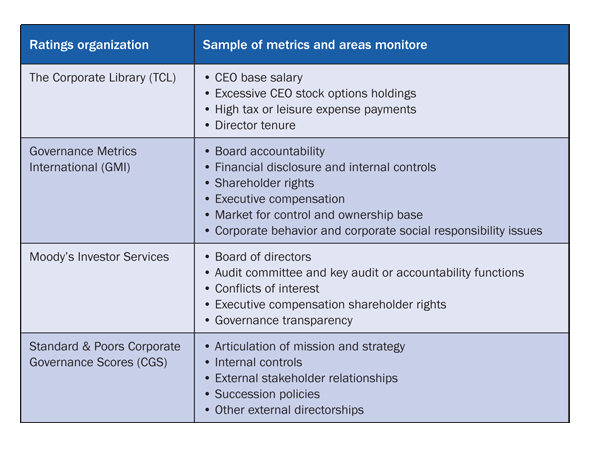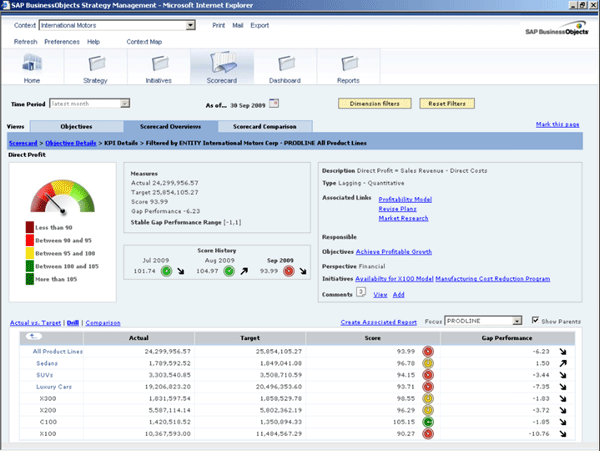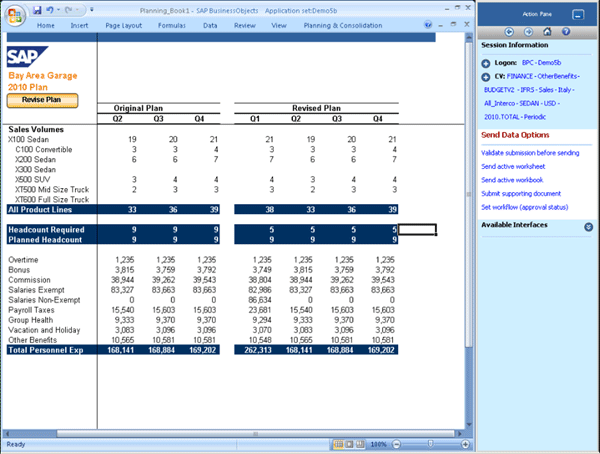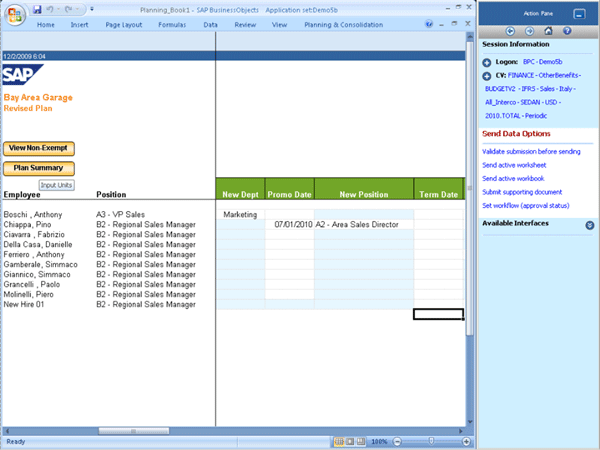As part of its positioning for the corporate boardroom set of enterprise performance management applications, SAP BusinessObjects Planning and Consolidation, version for SAP NetWeaver, allows for the transparency and flexibility to create predictive financial scenarios that can anticipate changes in the cost and corresponding investor relationship model. Learn how to increase performance by predicting capital asset ratings and enhance relationship management for effective governance using SAP BusinessObjects Planning and Consolidation and SAP BusinessObjects Strategy Management.
Key Concept
SAP BusinessObjects Planning and Consolidation and SAP BusinessObjects Strategy Management, as part of the enterprise performance management (EPM) solutions suite, allow you to quickly determine real-time changes to the key predictive indicators that ratings firms use to establish access to capital and liquidity instruments, as well as corporate and individual performance management target achievement.
The investor relationship model used by many publicly traded organizations relies on results and projections taken from financial models and operational roll-ups that correspond to actual performance versus planned performance. The accurate monitoring of key performance indicator (KPI) and strategic goal achievement in the organization are at the heart of this monitoring process. In addition, many individual performance management elements linked to executive reward and recognition systems use these results to determine both direct and indirect compensation models.
The handover to operational planning and financial execution has also been a source of greater examination of both financial executives and fund portfolio managers who seek returns for their investors in publicly traded enterprises. How the enterprise performs against predicted targets, viewed from both internal and external perspectives, can have a profound impact on the availability and cost of capital to execute operations and the perceived relationship of the organization in the marketplace.
The Increased Use of Governance Ratings
To determine the relative health of organizations, particularly publicly traded companies, several financial services firms and organizations offer products designed to provide financial and governance ratings for organizations. These ratings affect the cost of capital for organizations, the ease of obtaining working capital lines of credit, and other financial instruments required to fund business growth and company operations.
Table 1 considers a sampling of governance and financial ratings organizations. In general, ratings organizations consider a variety of metrics, with a key focus on the following categories of metrics, which may differ between ratings organizations:
- Executive and director compensation, including options plans, how these plans may be converted, and approval processes used to design and implement compensation models
- Board structure and practices, including the composition of the board and executive management team, separation of the chair and CEO positions, profile of board members, and other factors
- Shareholder rights and transparency, including the availability of information and timely communications to shareholders, their ability to act in the decision making process, and oversight provisions.

Table 1
Sample of ratings agencies and key metrics and monitoring areas
Note
I based Table 1 off a number of sources, primarily An Overview of Corporate Governance Ratings, Towers Perrin, 2004.
The challenge for financial executives and other professionals in this field is to anticipate the key groupings of metrics and the ratings companies integrate to calculate the grade, and to align with the chosen ratings system. This can become complex when considering a globally operating company that may rely on several financial institutions for various instruments and products to drive their strategic objectives. In addition, ratings firms have been shown in light of the recent financial crisis to not be full-proof in their ability to predict downstream corporate performance. As such, financial executives must keep in mind the balance between appeasing the financial institutions with which they engage and the focused strategic objectives of the organization.
SAP BusinessObjects Planning and Consolidation, combined with SAP BusinessObjects Strategy Management, can support a proactive relationship management function both inside and outside the organization. I’ll show you one scenario to map financial information into strategic KPI models for this purpose.
Note
William’s forthcoming SAP PRESS book
Understanding SAP BusinessObjects Enterprise Performance Management covers this and other topics. For more information, visit
www.sap-press.com.
Creating Predictive Financial Scenarios Using SAP BusinessObjects Business Planning and Consolidation
SAP BusinessObjects Planning and Consolidation provides everything needed to meet bottom-up and top-down financial and operational planning requirements, as well as complete consolidation and reporting. It is available through a single, unified user interface. Some of its features include:
- Improved agility: Quickly model new business scenarios and decide on a course of action that maximizes value creation
- Reduced cycle time: Finance and line-of-business managers can collaborate in a unified landscape, streamlining the process of creating and approving plans, budgets, and forecasts.
- Minimized business and compliance risk: Transparent financial data and a single version of the truth enable fast, accurate management and statutory reporting.
- Increased user productivity: An intuitive interface and familiar office tools help workers make the most of their time.
SAP provides two versions of SAP BusinessObjects Planning and Consolidation: SAP BusinessObjects Planning and Consolidation, version for Microsoft, and SAP BusinessObjects Planning and Consolidation, version for SAP NetWeaver. In this article I review the SAP NetWeaver platform, which uses the same front-end spreadsheet user interface (UI) as the Microsoft platform, making a consistent user experience across the organization.
SAP BusinessObjects Planning and Consolidation may receive information in a variety of ways, either through business intelligence environments where universes are created, through specific extensions into source data applications (such as SAP ERP modules) using an application data repository, or natively using the Pilot Application Server (PAS) data cache. The PAS data cache is an internal subset of information available across several of the EPM solution applications in the 7.5 release. This allows the object and data connectivity needed for executive users to access application data based on drill downs or required processes.
In this example, the vice president of sales and service for Vision Motors has noticed that there appears to be a deviation in service costs affecting the plan for several objectives for the year. This could be based on actual field events according to plan. The alert is first noticed by the scorecard home screen view of SAP BusinessObjects Strategy Management (Figure 1).

Figure 1
SAP BusinessObjects Strategy Management scorecard view alerting to a KPI issue in planned service costs
You can map key planning and financial information from the SAP BusinessObjects Strategy Management either through the PAS Data Cache or via the Application Repository to SAP BusinessObjects Planning and Consolidation. Users have the option of mapping into SAP BusinessObjects Strategy Management based on the data integrity and management strategy of their organization (e.g., from a source data application, an aggregator application such as SAP BusinessObjects Financial Information Management, or via SAP NetWeaver Business Warehouse InfoCubes using the information from the source data applications).
In the example of Vision Motors, the vice president has the ability to directly navigate to SAP BusinessObjects Planning and Consolidation, where the planned budget is compared and contrasted with the actual performance in the organization. In this example, you can break the service area into regions and particular sales partners in each region. One particular sales partner, Bay Area Garage, is showing in the line items a headcount level in its revised plan much higher than the original plan for the current fiscal year (Figure 2).

Figure 2
Linking to SAP BusinessObjects Planning and Consolidation shows planned versus an actual revised plan
With sales remaining flat for this part of the operations, the prudent action would be to consider aligning service costs to maintain cost and profit targets, and creating a new revised budget more in line with real-time information gathered from the field. SAP BusinessObjects Planning and Consolidation can allow drill downs into many resource areas of the business, including equipment, materials, and human resources. Several options exist to maintain personnel expenses. Some of the labor may be shifted to other partners who may find that their plans are exceeding goals, or who need to add labor due to retirement and attrition. Planned staffing hires may be postponed to bring real-time internal spend in alignment with sales performance. SAP BusinessObjects Planning and Consolidation allows the vice president to consider all options by viewing the next level of information in the area of human resources and labor costs shown in Figure 3.

Figure 3
SAP BusinessObjects Planning and Consolidation provides drill down into resource categories including personnel
Once the staffing levels have been adjusted according to plan and actual forecast, the updated revised plan can then show consistency with sales levels and budgeted staffing levels (Figure 4).

Figure 4
Revised plan now accurately reflects consistent staff levels
Note
SAP BusinessObjects Planning and Consolidation 7.5, version for SAP NetWeaver, is generally available (GA) software and part of the SAP BusinessObjects Enterprise Performance Management (EPM) 7.5 solution suite.
Once the update is made in SAP BusinessObjects Planning and Consolidation, the vice president may then return to SAP BusinessObjects Strategy Management to review the changes on the planned scorecards. The executive now has easy visibility into the corporate scorecard of the services costs as a component of gross margin KPI levels without the need to make specific requests to the finance department for additional and updated reports.
In this way, through the use of SAP BusinessObjects Enterprise Performance Management solutions, Vision Motors can make proactive adjustments to its operations, preserving and protecting the margin targets it has made to its employees and stakeholders.

William Newman
William Newman, MBA, CMC is managing principal of Newport Consulting Group, LLC, an SAP partner focused on EPM and GRC solutions. He has over 25 years of experience in the development and management of strategy, process, and technology solutions spanning Fortune 1000, public-sector, midsized and not-for-profit organizations. He is a Certified Management Consultant (CMC) since 1995, qualified trainer by the American Society of Quality (ASQ) since 2000, and a trained Social Fingerprint consultant in social accountability since 2012. William is a recognized ASUG BusinessObjects influencer and a member of SAP’s Influencer Relations program. He holds a BS degree in aerospace engineering from the Henry Samueli School of Engineering and Applied Science at UCLA and an MBA in management and international business from the Conrad L. Hilton School of Management at Loyola Marymount University. He is a member of the adjunct faculty at both Northwood University and the University of Oregon with a focus on management studies and sustainability, respectively.
If you have comments about this article or BI Expert, or would like to submit an article idea, please contact the editor.
You may contact the author at wnewman@newportconsgroup.com.
If you have comments about this article or publication, or would like to submit an article idea, please contact the editor.










